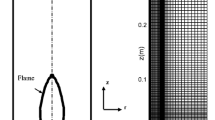Abstract
The reduced mechanism coupled with 2D flame code using CHEMKIN II to investigate the effect of gravity on flame structure and soot formation in diffusion flames. The results show that the gravity has a rather significant effect on flame structure and soot formation. The visible flame height and peak soot volume fraction in general increases with the gravity from 1g decreased to 0g. The peak flame temperature decreases with decreasing gravity level. Comparing the calculated results from 1g to 0g, the flame shape becomes wider, the high temperature zone becomes shorter, the mixture velocity has a sharp decrease, the soot volume fraction has a sharp increase and CO and unprovided species distribution becomes wider along radial direction. At normal and half gravity, the flame is buoyancy controlled and the axial velocity is largely independent of the coflow air velocity. At microgravity (0g), the flame is momentum controlled.
Similar content being viewed by others
References
V. V. Azatyan, Russ. J. Phys. Chem. A 87, 1295 (2013).
Y. D. Zhang, C. Lou, M. L. Xie, et al., J. Cent. South Univ. Technol. 18, 1263 (2011).
F. Liu, H. Guo, G. J. Smallwood, et al., Combust. Theory Model. 7, 301 (2003).
F. Liu, H. Guo, G. J. Smallwood, et al., Combust. Flame 145, 324 (2006).
Y. N. Shebeko, I. A. Bolod’yan, A. Y. Shebeko, et al., Russ. J. Phys. Chem. A 83, 618 (2009).
V. V. Azatyan and G. P. Saikova, Russ. J. Phys. Chem. A 87, 1615 (2013).
T. D. Khokhlova, N. K. Shonija, and O. B. Popovicheva, Russ. J. Phys. Chem. A 86, 120 (2012).
W. Wang, Master Thesis of Institute of Engineering Thermophysics (Chinese Academy of Sciences, 2003).
R. Friedman, K. R. Sacksteder, and D. Urban, Designs and Research for Fire Safety in Spacecraft, NASA TM, 105317 (NASA, 1991).
R. Friedman, Fire Safety in Extraterrestrial Environments, NASA/TM, 207417 (1998).
S. L. Olson and J. S. T’ien, Combust. Flame 121, 439 (2000).
J. L. Torero, T. Vietoris, G. Legros, et al., Combust. Sci. Tech. 174, 187 (2002).
M. Y. Bahadori, R. B. Edelman, D. P. Stocker, et al., AIAA J. 28, 236 (1990).
B. Konsur, C. M. Megaridis, and D. W. Griffin, Combust. Flame 116, 334 (1999).
D. L. Urban, Z. G. Yuan, P. B. Sunderland, et al., Proc. Combust. Inst. 28, 1965 (2000).
C. R. Kaplan, E. S. Oran, and K. Kailasanath, Proc. Combust. Inst. 26, 1301 (1996).
W. Kong and F. Liu, Combust. Theory Model. 13, 993 (2009).
K. C. Lin, G. M. Faeth, P. B. Sunderland, et al., Combust. Flame 116, 415 (1999).
C. M. Megaridis, D. W. Griffin, and B. Konsur, Proc. Combust. Inst. 26, 1291 (1996).
G. P. Smith, D. M. Golden, M. Frenklach, et al., GRI-Mech, version 3.0 (2002). http://www.me.berkeley.edu/gri-mech/
Y. Zhang, H. Zhou, M. Xie, et al., Chin. J. Chem. Eng. 18, 967 (2010).
C. K. Law and S. H. Chung, Combust. Sci. Techn. 29, 129 (2007).
J. B. Moss, C. D. Stewart, and K. J. Young, Combust. Flame 101, 491 (1995).
K. M. Leung, R. P. Lindstedt, and W. P. Jones, Combust. Flame 87, 289 (1991).
A. Massias, D. Diamantis, E. Mastorakos et al., Combust. Flame 117, 685 (1999).
R. W. Bilger, S. H. Starner, and R. J. Kee, Combust. Flame 80, 135 (1990).
F. G. Roper, C. Smith, and A. C. Cunningham, Combust. Flame 29, 227 (1977).
F. G. Roper, Combust. Flame 29, 219 (1977).
Author information
Authors and Affiliations
Corresponding author
Additional information
The article is published in the original.
Rights and permissions
About this article
Cite this article
Zhang, Y., Liu, D., Li, S. et al. The influence of gravity levels on soot formation for the combustion of ethylene-air mixture. Russ. J. Phys. Chem. 88, 2300–2307 (2014). https://doi.org/10.1134/S0036024414130317
Received:
Published:
Issue Date:
DOI: https://doi.org/10.1134/S0036024414130317




